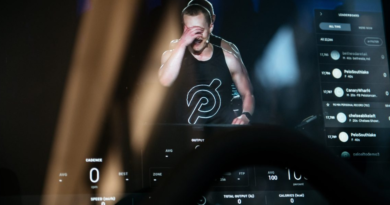Microsoft traces fake Kamala Harris hit-and-run video back to Russian troll farm
The video was seen millions of times across social media but some viewers were suspicious: It featured a young Black woman who claimed Vice President Kamala Harris left her paralyzed in a hit-and-run accident in San Francisco 13 years ago.
In an emotional retelling from a wheelchair, the alleged victim said she “cannot remain silent anymore” and lamented that her childhood had “ended too soon.”
Immediately after the video was posted on Sept. 2, social media users pointed out reasons to be wary. The purported news channel it came from, San Francisco’s KBSF-TV, didn’t exist. A website for the channel set up just a week earlier contained plagiarized articles from real news outlets. The woman’s X-ray images shown in the video were taken from online medical journals. And the video and the text story on the website spelled the alleged victim’s name differently.
The caution was warranted, according to a new Microsoft threat intelligence report, which confirms the fabricated tale was disinformation from a Russia-linked troll farm.
The tech giant’s report released Tuesday details how Kremlin-aligned actors that at first struggled to adapt to President Joe Biden dropping out of the race have now gone full throttle in their covert influence efforts against Harris and Democrats.
It also explains how Russian intelligence actors are collaborating with pro-Russian cyber “hacktivists” to boost allegedly hacked-and-leaked materials, a strategy the company notes could be weaponized to undermine U.S. confidence in November’s election outcome.
The findings reveal how even through dramatic changes in the political landscape, groups linked to America’s foreign adversaries have redoubled their commitment to sway U.S. political opinion as the election nears, sometimes through deeply manipulative means. They also provide further insight into how Russia’s efforts to fight pro-Ukrainian policy in the U.S. are translating into escalating attacks on the Democratic presidential ticket.
The report builds on previous concerns the U.S. has had about Russian interference in the upcoming election. Earlier this month, the Biden administration seized Kremlin-run websites and charged two Russian state media employees in an alleged scheme to secretly fund and influence a network of right-wing influencers.
Russia-linked actors have spent several months seeking to manipulate American perspectives with covert postings, but until this point, their efforts saw little traction. Notably, some of the recent examples cited in the Microsoft report received significant social media engagement from unwitting Americans who shared the fake stories with outrage.
“As the election approaches, people get more heated,” Clint Watts, general manager of the Microsoft Threat Analysis Center said in an interview. “People tend to take in information from sources they don’t really know or wouldn’t even know to evaluate.”
Microsoft explained that the video blaming Harris for a fake hit-and-run incident came from a Russian-aligned influence network it calls Storm-1516, which other researchers refer to as CopyCop. The video, whose main character is played by an actor, is typical of the group’s efforts to react to current events with authentic-seeming “whistleblower” accounts that may seem like juicy unreported news to U.S. voters, the company said.
The report revealed a second video disseminated by the group, which purported to show two Black men beating up a bloodied white woman at a rally for Republican presidential nominee Donald Trump. The video racked up thousands of shares on the social platform X and elicited comments like, “This is the kind of stuff to start civil wars.”
Microsoft’s report also pointed to another Russian influence actor it calls Storm-1679 that has recently pivoted from posting about the French election and the Paris Olympics to posting about Harris. Earlier this month, the group posted a manipulated video depicting a Times Square billboard that linked Harris to gender-affirming surgeries.
The content highlighted in the report doesn’t appear to use generative artificial intelligence tools. It instead uses actors and more old-school editing techniques.
Watts said Microsoft has been tracking the use of AI by nation states for more than a year and while foreign actors tried AI initially, many have gone back to basics as they’ve realized AI was “probably more time-consuming and not more effective.”
Asked about Russia’s motivation, Watts said the Russia-aligned groups Microsoft tracks may not necessarily support particular candidates, but they are motivated to undermine anyone who “is supporting Ukraine in their policy.”
Harris has vowed to continue supporting America’s ally Ukraine in its fight against Russia’s invasion if elected president. Trump has demurred when asked about whether he wants Ukraine to win the war, saying in the recent presidential debate, “ I want the war to stop.”
At a forum in early September, Russian President Vladimir Putin appeared to suggest jokingly that he would support Vice President Kamala Harris in the upcoming U.S. election. Intelligence officials have said Moscow prefers Trump.
The Harris campaign declined to comment. The Russian embassy in Washington did not immediately respond to emailed requests for comment.
Earlier this summer, Microsoft found that Iranian groups have also been laying the groundwork to stoke division in the election by creating fake news sites, impersonating activists and targeting a presidential campaign with an email phishing attack.
U.S. intelligence officials are preparing criminal charges in connection with that attack, which targeted the Trump campaign, two people familiar with the matter told The Associated Press.
Microsoft’s new report also touches on how a Chinese-linked influence actor has used short-form video to criticize Biden and Harris and to create anti-Trump content, suggesting it doesn’t appear interested in supporting a particular candidate.
Instead, the company said, the China-aligned group’s apparent goal is to “seed doubt and confusion among American voters ahead of the 2024 presidential election.”



